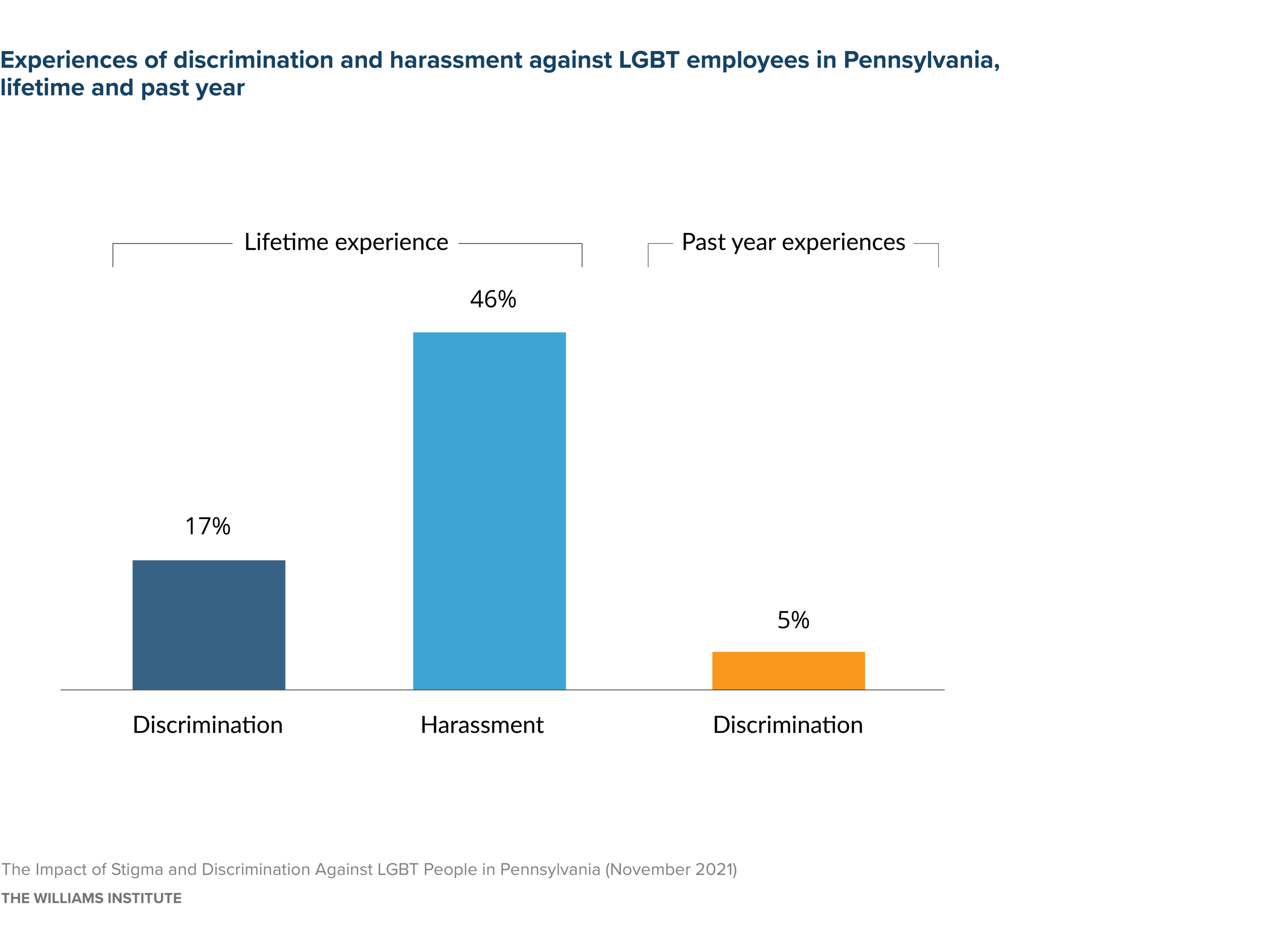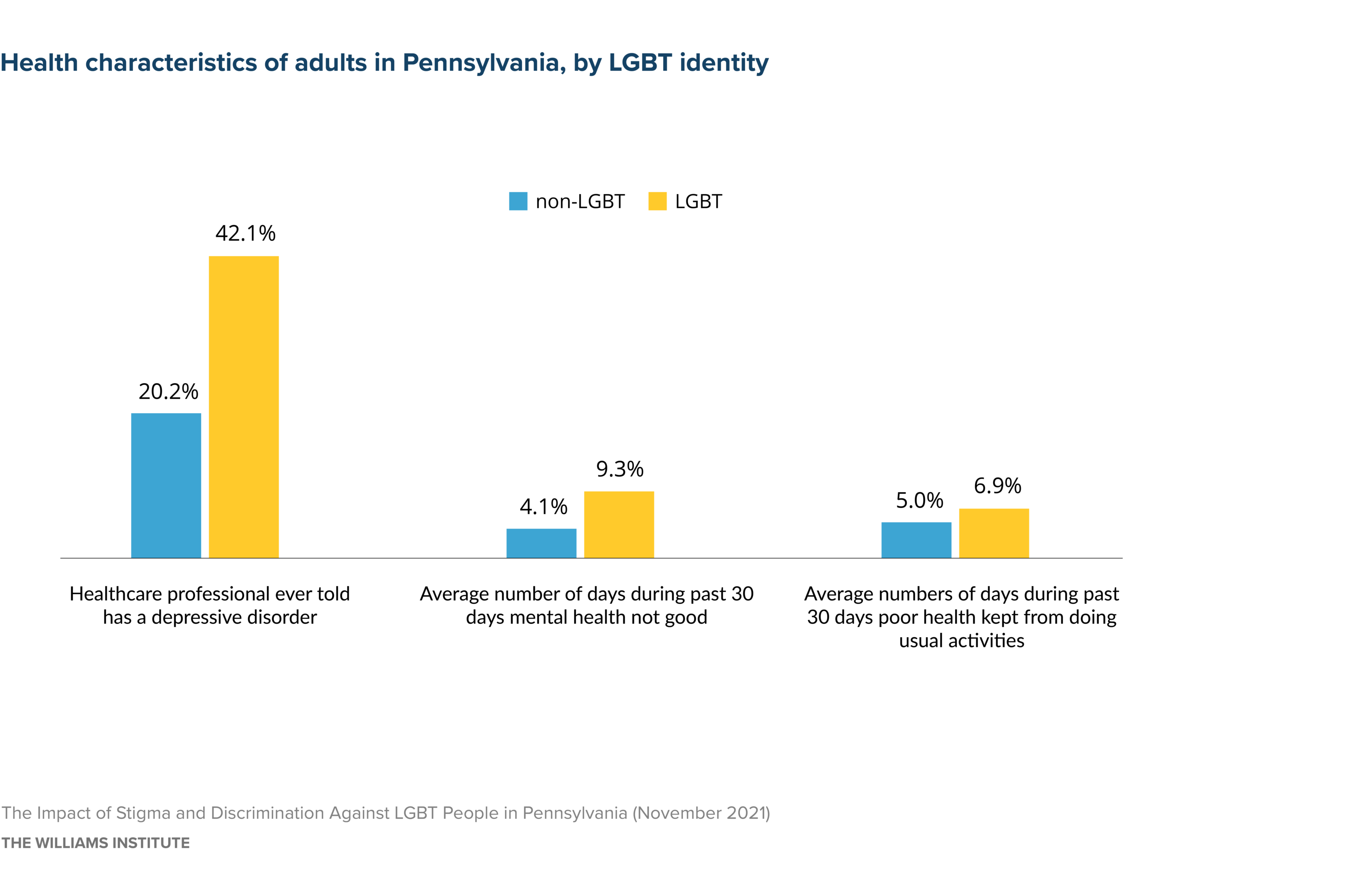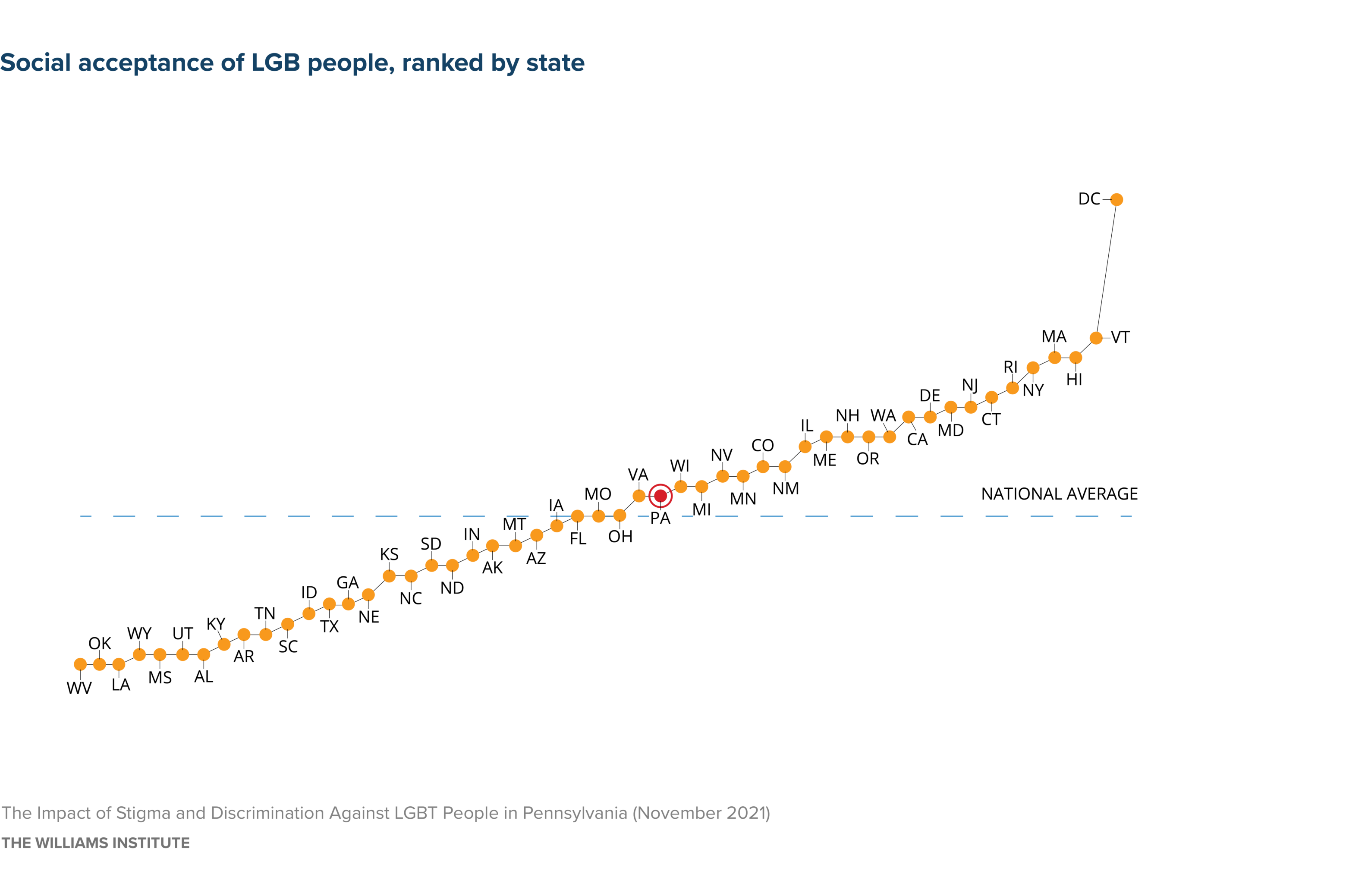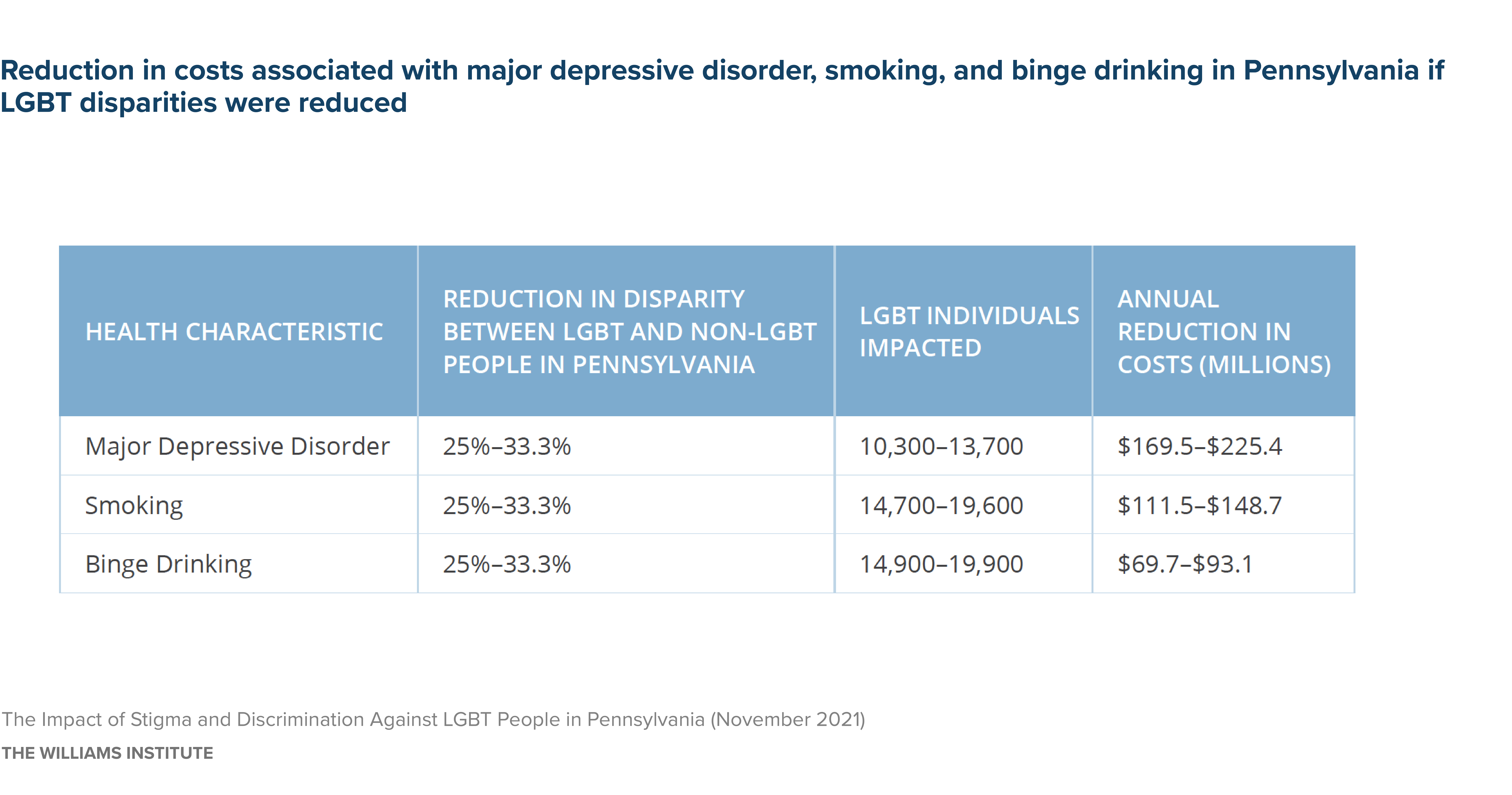Executive Summary
Pennsylvania is home to an estimated 416,000 LGBT adults and approximately 74,000 LGBT youth. The state offers some protections for LGBT people, but also lacks a number of laws and policies that have been enacted to support LGBT people in other states. Pennsylvania’s statewide nondiscrimination law does not expressly include protections from discrimination based on sexual orientation or gender identity, however, the Pennsylvania Human Relations Commission has interpreted the law to protect LGBT people since 2018. This decision expanded statewide legal protections for LGBT people even before the U.S. Supreme Court held that discrimination based on sexual orientation and gender identity violates federal non-discrimination laws. Despite these protections, Pennsylvania lacks several other types of supportive laws and policies that have been enacted in other states, including an LGBT-inclusive hate crimes law, LGBT-inclusive anti-bullying policies, and a ban on the practice of conversion therapy. In terms of social climate, Pennsylvania ranks 24th in the nation, as measured by public support for LGBT rights and acceptance of LGBT people.
The legal landscape for LGBT people in Pennsylvania likely contributes to an environment in which LGBT people continue to experience stigma and discrimination. Stigma and discrimination can take many forms, including discrimination and harassment in employment and other settings; bullying and harassment at school and family rejection of LGBT youth; overrepresentation in the criminal legal system; and violent victimization. Research has linked stigma and discrimination against LGBT people to negative effects on individuals, businesses, and the economy.
In this study, we provide data and research documenting the prevalence of several forms of stigma and discrimination against LGBT adults and youth in the U.S. and in Pennsylvania specifically, including discrimination and harassment in employment, housing, and places of public accommodation; bullying and harassment in schools; and family rejection of LGBT youth. We discuss the implications of such stigma and discrimination on LGBT individuals, in terms of health and economic security; on employers, in terms of employee productivity, recruitment, and retention; and on the economy, in terms of health care costs and reduced productivity.
To the extent that Pennsylvania can create a more supportive environment for LGBT people, it will reduce the economic instability and health disparities experienced by LGBT individuals, which, in turn, would benefit the state, employers, and the economy.
Key Findings
Prevalence of Stigma and Discrimination Against LGBT People
LGBT people in Pennsylvania experience discrimination in employment, housing, and public accommodations:
- A 2021 nationwide survey of LGBT employees found that nearly half (47%) of LGBT respondents from Pennsylvania reported experiencing workplace discrimination or harassment because of their sexual orientation or gender identity at some point in their lives. More specifically, 17% of respondents from Pennsylvania reported experiencing employment discrimination (including being fired or not hired) because of their sexual orientation or gender identity. Forty-six percent of LGBT respondents from Pennsylvania reported experiencing at least one form of harassment (verbal, physical, or sexual harassment) at work because of their sexual orientation or gender identity.
- In response to the 2021 survey, 5% of LGBT employees from Pennsylvania reported that they had experienced discrimination (including being fired or not hired) within the year following the U.S. Supreme Court’s decision in Bostock v. Clayton County, extending non-discrimination protections to LGBT people nationwide.

Source: Employment Experiences Survey, 2021
In 2019, 10% of discrimination suits brought before the City of Pittsburgh’s Human Relations Commission were based on sexual orientation, gender identity, or gender expression.
- In response to a 2016 poll, 57% of Pennsylvania residents—both LGBT and non-LGBT—said that they thought that gay and lesbian people experience a lot of discrimination in the U.S., and 61% said that they thought that transgender people experience a lot of discrimination in the U.S.
- The 2015 U.S. Transgender Survey found that among respondents in Pennsylvania, 23% of transgender people who held or applied for a job within the prior year reported being fired, denied a promotion, or not being hired because of their gender identity or expression. Further, 21% of transgender respondents in the state reported having experienced some form of housing discrimination in the past year, such as being evicted from their home or denied a home or apartment because of being transgender, and 10% reported that they experienced homelessness in the past year because of being transgender. In addition, of those respondents who visited a place of public accommodation where staff or employees knew or thought they were transgender, 31% experienced at least one type of mistreatment in the past year because of being (or being perceived to be) transgender.
- Incidents of discrimination against LGBT people in employment, housing, and in places of public accommodation in Pennsylvania have also been documented in a number of court cases, media reports, and other sources.
LGBT youth in Pennsylvania experience bullying and harassment at school:
- Data collected by the state in 2019 indicate that, when compared to heterosexual students, LGB students in Pennsylvania were almost twice as likely to report being bullied both at school (32.9% vs. 17.2%) and electronically (26.8% vs. 12.3%) in the year prior to the survey. Similarly, LGB students in the state were more likely than heterosexual students to report being in a physical fight in the year prior to the survey (26.2% vs. 20.5%), and to report being threatened or injured with a weapon on school property (10.9% vs. 6.8%).
- A 2020 survey at Pennsylvania State University found that 22% of all students reported hearing insensitive or disparaging remarks on the basis of sexual orientation sometimes while on campus; 7% heard such remarks often, and 3% very often. Respondents were more likely to report hearing insensitive or disparaging remarks on the basis of non-binary or gender-nonconforming identity, with 33% hearing those remarks sometimes, 21% often, and 16% very often.
- Among Pennsylvania students interviewed through the 2019 GLSEN National School Climate survey of LGBTQ middle- and high-school students, 10% reported experiencing physical assault at school because of either their sexual orientation or gender expression in the year prior to the survey. Similarly, 24% said they had experienced physical harassment at school based on their sexual orientation, and 20% based on their gender expression, in the year prior to the survey. A majority of Pennsylvania respondents reported experiences with verbal harassment at school based on their sexual orientation (71%) or gender expression (56%) in the year prior to the survey. Among LGBTQ students who were bullied or harassed at Pennsylvania schools, only 51% reported the incident to school staff. And, only 22% of those who reported bullying or harassment to staff said that it resulted in effective intervention.
- Pennsylvania students interviewed by Human Rights Watch in 2016 consistently reported that anti-LGBTQ slurs were “ubiquitous” in their schools, even in those seen as LGBT-friendly, and that slurs would frequently be used to “belittle or taunt peers, whether or not the targets identified as LGBT.” Interviews with both students and teachers suggest that, for many Pennsylvania school employees, the choice to not intervene is deliberate.
- The 2015 U.S. Transgender Survey found that 77% of Pennsylvania respondents who were out or perceived as transgender at some point between kindergarten and 12th grade reported experiencing some form of mistreatment, such as being verbally harassed, prohibited from dressing according to their gender identity, disciplined more harshly, or physically or sexually assaulted because people thought that they were transgender. Furthermore, 12% said that the harassment they experienced was so severe that they had to leave a K-12 school.
- Instances of bullying and harassment in education in Pennsylvania have also been documented in a number of court cases, administrative complaints, and media reports.
Impact of Stigma and Discrimination on LGBT Individuals
LGBT people in Pennsylvania experience economic instability:
- Stigma and discrimination against LGBT workers can lead to economic instability, including lower wages and higher rates of poverty.
- Gallup polling data from 2015–2017 show that 25.9% of LGBT adults in Pennsylvania reported that they did not have enough money for food, compared to 13.1% of non-LGBT adults in the state. Similarly, 26.5% of LGBT adults in Pennsylvania reported having a household income below $24,000, compared to 18.3% of non-LGBT adults. In addition, 10.5% of LGBT adults in Pennsylvania reported being unemployed, compared to 5.2% of non-LGBT adults.
LGBT adults and youth in Pennsylvania experience health disparities:
- Research indicates that stigma and discrimination contribute to adverse health outcomes for LGBT adults, such as major depressive disorder, binge drinking, substance use, and suicidality. Similarly, bullying and family rejection, as well as social stigma more broadly, have been linked to increased likelihoods of dropping out of school, suicide, and substance use among LGBT youth.
- LGBT adult respondents to the 2017 and 2018 Pennsylvania Behavioral Risk Factor Surveillance System survey were significantly more likely to have been diagnosed with a depressive disorder by a health care professional than non-LGBT respondents (42.1% vs. 20.2%). In addition, LGBT adults in Pennsylvania were significantly more likely to report current smoking (31.7% vs. 17.5%) and binge drinking (31.0% vs. 16.6%) than non-LGBT adults.

Source: 2017–2018 Pennsylvania BRFSS
Economic Impacts of Stigma and Discrimination
Discrimination against LGBT people in employment and other settings has economic consequences for employers and the state government:
- Productivity. Unsupportive work environments can mean that LGBT employees are less likely to be open about their sexual orientation or gender identity at work, and more likely to be distracted, disengaged, or absent, and to be less productive. These outcomes could lead to economic losses for state and local governments, as employers, as well as for private-sector employers in the state. Given that an estimated 307,000 workers ages 16 and over in Pennsylvania identify as LGBT, the loss in productivity from a discriminatory environment could be significant.
- Retention. LGBT employees in less supportive work environments feel less loyal to their employers and are more likely to plan to leave their jobs. A recent survey found that 11% of LGBT employees who live in Pennsylvania have left a job because of how they were treated by an employer based on their sexual orientation or gender identity at some point in their lives, and 38% have looked for other jobs because of how they were personally treated by their employer or because the workplace environment was uncomfortable for LGBT people in general. Given the average replacement costs of an employee, public and private employers risk losing $10,790, on average, for each employee who leaves the state or changes jobs because of an unsupportive environment in Pennsylvania.
- Recruitment. Many LGBT and non-LGBT workers, in particular those who are younger and more highly educated, prefer to work for companies with more LGBT-supportive policies, and in states with more supportive laws. To the extent that workers from other states perceive Pennsylvania to be unsupportive of LGBT people, it may be difficult for public and private employers in the state to recruit talented employees from other places.
Bullying, harassment, and family rejection of LGBT youth negatively impact the economy:
- Bullying, harassment, and family rejection of LGBT youth can cause them to miss or drop out of school, experience homelessness, or become unemployed or underemployed.
- Underattendance at school and experiences with homelessness that arise due to bullying, harassment, and family rejection are harmful not only to individual LGBT youth, but also have societal consequences in that they reduce the capacity of these youth to contribute to the economy as adults.
- In addition, school-based harassment and family rejection can increase costs to the state via Medicaid expenditures, incarceration, and lost wages. The Annie E. Casey Foundation has estimated that homelessness, juvenile justice involvement, and poor educational and employment outcomes cost nearly $8 billion per cohort that ages out of foster care each year in the U.S. The best available data suggest that LGBT youth make up one-fifth, if not more, of each annual aging-out cohort.
Health disparities for LGBT people negatively impact the economy:
- A more supportive legal landscape and social climate for LGBT people in Pennsylvania is likely to reduce health disparities between LGBT and non-LGBT people, which would increase worker productivity and reduce health care costs.
- We estimate that reducing the disparity in Major Depressive Disorder between LGBT and non-LGBT people in Pennsylvania by 25% to 33.3% could benefit the state’s economy by $169.5 to $225.4 million annually. Reducing the disparity in current smoking by the same proportion could benefit the state’s economy by $111.5 to $148.7 million, and similarly reducing the disparity in binge drinking could benefit the state’s economy by $69.7 to $93.1 million in increased productivity and reduced health care costs each year. To the extent that a more supportive legal landscape would reduce other health disparities, the state’s economy would benefit even more.



